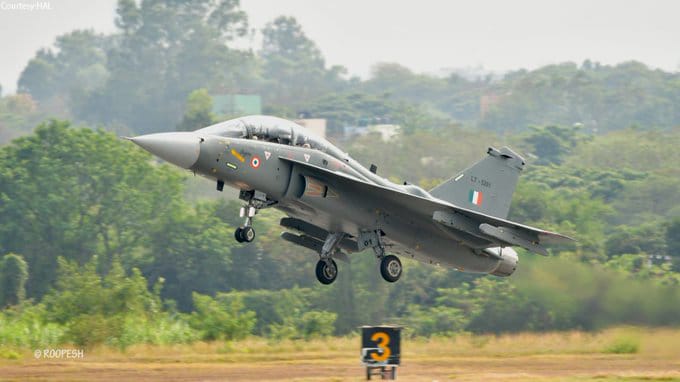Aviation
HAL’s Indigenous Tejas MK-1A completes its first maiden flight

The inaugural flight of the first production series fighter of LCA Tejas Mark-1A, an advanced iteration of the LCA Mk-1 recently inducted by the Indian Air Force (IAF), completed its maiden flight in Bengaluru Today.
Over the past several days, the Defence PSU HAL has been conducting various taxi trials in preparation for this milestone.
The maiden flight lasted 18 minutes and marked a triumph for the project. The Mk-1A boasts several enhancements, including digital radar warning receivers, an advanced AESA radar, improved beyond-visual-range (BVR) air-to-air missiles, and external self-protection jammer pods.
The upgraded Tejas Mark 1A aircraft features a larger cockpit canopy, enhancing the pilot’s outside visibility and facilitating better movement of their helmet. Additionally, the air intake has been redesigned to supply faster airflow to the engine, enhancing performance. Modifications to the vertical radar in the tail section have been made to improve control during turns. Overall, these upgrades elevate the aircraft’s standards compared to previous versions, providing increased comfort and functionality.
Under a contract worth Rs 46,898 crore signed in 2021, HAL is mandated to deliver 83 Tejas Mk-1A jets between March 2024 and February 2028. This follows the completion of the order for 40 Tejas Mk1 jets valued at Rs 8,802 crore, of which 32 single-seat fighters and two twin-seat trainers have already been delivered.
The IAF, which currently operates two Tejas squadrons named ‘Flying Daggers’ and ‘Flying Bullets’, has deployed one squadron in the southwestern sector. Recognizing the significance of the Tejas in bolstering its fleet, the Defence Acquisition Council (DAC) has approved the acquisition of an additional 97 Tejas Mk-1A aircraft. However, the final clearance from the cabinet committee on security (CCS) is pending before the order can be placed.
With the IAF grappling with a decline in the number of its fighter squadrons, which currently stands at 31 against the required 42 to effectively counter threats from China and Pakistan, the Tejas assumes a crucial role in filling this gap. Despite initial skepticism, the Tejas has evolved into a flagship platform for India, garnering attention and accolades at numerous defense and aerospace exhibitions worldwide.
However, it is essential to note that the IAF recently experienced its first loss of a Tejas Mk 1 fighter aircraft due to an air crash on March 12.

Aviation
Boeing, Antonov to Collaborate on Defense Projects

– MOU represents Boeing’s commitment to work with Ukrainian industry
– Includes exploring opportunities for collaborating on in-country support of Unmanned Aerial Systems
A Memorandum of Understanding was signed today by Boeing and Antonov Company to investigate potential collaboration on defense-related projects.
“We’re happy to keep collaborating with the Antonov Company to help Ukraine’s economic development and expansion,” stated Ted Colbert, CEO and president of Boeing Defence, Space, & Security.
Airbus and the Antonov An-225: The Best Partnership:Click here
“This agreement demonstrates our ongoing efforts to find more opportunities to work with Ukrainian industry, which was underscored by our signing of the Ukrainian Defence Industry Compact earlier this year.”
The areas of potential collaboration identified in the agreement consist of training, logistical support and overhaul services for tactical Unmanned Aerial Systems utilized by the Ukrainian Armed Forces, which includes the ScanEagle. In addition, the companies will also explore opportunities for Antonov to provide engineering support to Boeing.
The six largest cargo aircraft ever built in the aviation industry:Click here
“A strong, innovative, and efficient defense industry is key to sustainable economic development and national security, and we are extremely excited to collaborate with Boeing,” said Ievhen Gavrylov, CEO of Antonov Company.
This agreement brings a whole new level of opportunity to implement the latest and most effective solutions – in addition to the possibility of future projects with Boeing in the aerospace and defense industry.”
-

 Travel1 week ago
Travel1 week agoAir India to Expand US Operations with Three New Routes After a Decade
-

 Travel2 weeks ago
Travel2 weeks agoWhy We Should Avoid These Stamps in a Passport
-

 Airlines1 month ago
Airlines1 month agoInvestigations Reveal Fake Chinese Titanium in Boeing and Airbus Jets
-

 Tech4 weeks ago
Tech4 weeks agoChina’s CATL Plans 1,800-Mile Electric Plane Launch by 2027
-

 Airport3 days ago
Airport3 days agoTop 10 Largest Airports in the World by Size
-

 Aerospace4 weeks ago
Aerospace4 weeks agoChina’s Fighter Jets Turn Wings into Autonomous Drones
-

 Airlines4 days ago
Airlines4 days agoAir India Rolls Out A350s for Delhi-New York JFK and Newark Routes
-

 Defence3 weeks ago
Defence3 weeks agoBoeing Enhances Chinook with New Engines and Block II Upgrades at $96 Million







